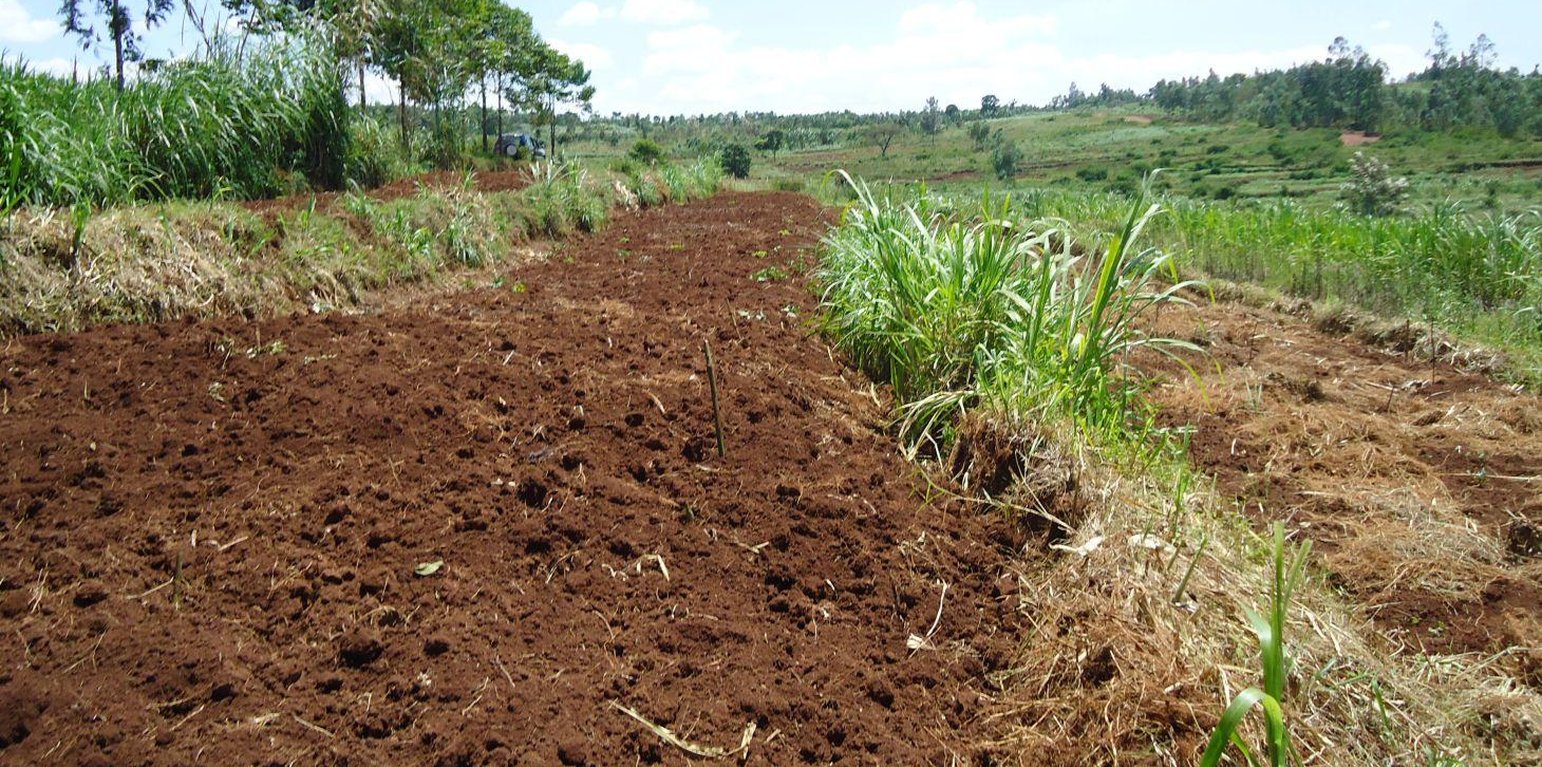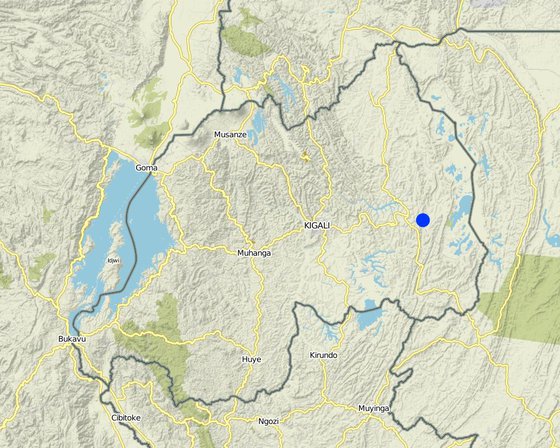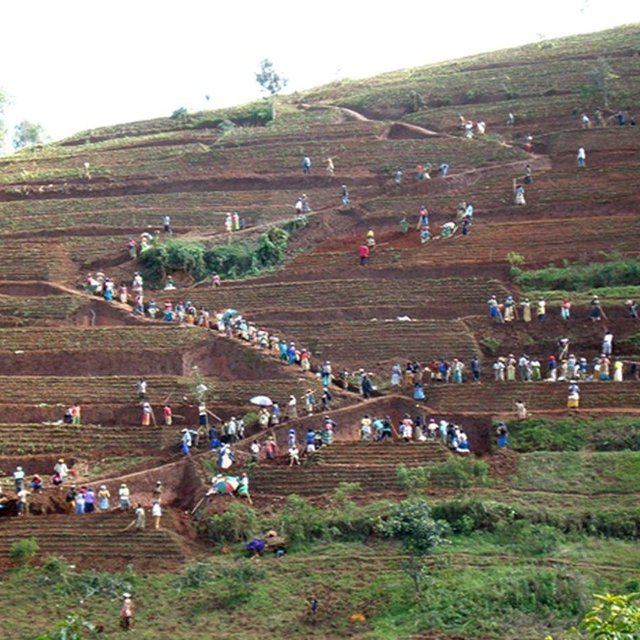



In Rwanda, a unique method of back-slope terracing originally introduced by missionaries growing wheat in the Northern Province in the 1970s, has been widely adopted by smallholder farmers in many parts of the country. The farmers are careful to isolate the topsoil, then they re-work the subsoil to create the required reverse-slope bench, after which the topsoil is spread over the surface. The riser is planted with short runner grass for stabilization, all within the same day. Radical terracing is usually done manually with hoes and shovels, mostly by communal group-work involving hundreds of farmers (see left photo). Thus, a hillside can be terraced in one day. Where radical terraces have been constructed, the effects have been dramatic, achieving optimum water and soil conservation on slopes exceeding 50%, while adoption rates have been quite extensive. This high adoption of radical terracing is related to the existing policies and programs such as land consolidation, land management and crop intensification programs. These policies/programs boost the use of radical terraces by providing farmers more opportunities to easily access inputs such as improved seeds and manure for increasing the productivity of constructed radical terraces. Recent studies (e.g. Fleskens, 2007, Bizoza and de Graaff 2012 and Kagabo et al. 2013) assert that radical terraces in the highlands of Rwanda are only financially viable when the opportunity cost of labour and manure are below the local market price levels and when agriculture area on these radical terraces can be substantially intensified. Ten to 30 metric tons of manure (organic) are required to restore the soil fertility of newly established radical terraces.
Purpose of the Technology: In Rwanda, radical terraces are principally designed (1) to reduce soil losses through enhanced retention and infiltration of runoff, (2) to promote permanent agriculture on steep slopes and (3) to promote land consolidation and intensive land use.
Establishment / maintenance activities and inputs: Newly established radical terraces should be protected at their risers and outlets, especially in the first or second year of the establishment. After establishing a terrace, a riser is shaped and grasses or shrubs/trees are planted soon after. Napier grass is commonly planted and is used as forage for livestock. Risers on radical terraces are seen as a new production niche of forage as a result of land shortage and a strict zero grazing policy.
Natural / human environment: Radical terraces have the potential of improving farmers’ livelihoods and increasing the resilience of a degraded environment.

สถานที่: Kayonza District (Eastern province), Rwanda, รวันดา
ตำนวนการวิเคราะห์เทคโนโลยี:
การเผยแพร่ของเทคโนโลยี: กระจายไปอย่างสม่ำเสมอในพื้นที่ (10.3 km²)
In a permanently protected area?:
วันที่ในการดำเนินการ: น้อยกว่า 10 ปี (ไม่นานนี้)
ประเภทของการแนะนำ






| ปัจจัยนำเข้า | หน่วย | ปริมาณ | ค่าใช้จ่ายต่อหน่วย (Rwandan francs) | ค่าใช้จ่ายทั้งหมดต่อปัจจัยนำเข้า (Rwandan francs) | %ของค่าใช้จ่ายที่ก่อให้เกิดขึ้นโดยผู้ใช้ที่ดิน |
| แรงงาน | |||||
| Cuttings of grasses | persons/day/ha | 2.0 | 1000.0 | 2000.0 | 60.0 |
| Transport of grass cuttings | persons/day/ha | 10.0 | 1000.0 | 10000.0 | |
| Planting of grass cuttings | persons/day/ha | 20.0 | 1000.0 | 20000.0 | 100.0 |
| Land surveying (slope determination, soil structure and texture | persons/day/ha | 6.0 | 20000.0 | 120000.0 | |
| ปุ๋ยและสารฆ่า/ยับยั้งการเจริญเติบโตของสิ่งมีชีวิต (ไบโอไซด์) | |||||
| Lime | kg/ha | 2500.0 | 40.0 | 100000.0 | |
| Famyard manure | kg/ha | 30000.0 | 5.0 | 150000.0 | |
| Mineral fertilizers | kg/ha | 300.0 | 500.0 | 150000.0 | |
| อื่น ๆ | |||||
| Labour: Construction of bunds | persons/day/ha | 100.0 | 1000.0 | 100000.0 | |
| Labour: Level terraces bed | persons/day/ha | 250.0 | 1000.0 | 250000.0 | |
| Labour: Cutting subsurface soil | persons/day/ha | 250.0 | 1000.0 | 250000.0 | |
| Labour: Make lips on edges of terraces | persons/day/ha | 10.0 | 1000.0 | 10000.0 | |
| Labour: Compact risers | persons/day/ha | 50.0 | 1000.0 | 50000.0 | |
| Labour: Plant grasses including agro-forestery trees | persons/day/ha | 50.0 | 1000.0 | 50000.0 | |
| ค่าใช้จ่ายทั้งหมดของการจัดตั้งเทคโนโลยี | 1'262'000.0 | ||||
| Total costs for establishment of the Technology in USD | 1'971.88 | ||||
| ปัจจัยนำเข้า | หน่วย | ปริมาณ | ค่าใช้จ่ายต่อหน่วย (Rwandan francs) | ค่าใช้จ่ายทั้งหมดต่อปัจจัยนำเข้า (Rwandan francs) | %ของค่าใช้จ่ายที่ก่อให้เกิดขึ้นโดยผู้ใช้ที่ดิน |
| แรงงาน | |||||
| Weeding | persons/day/ha | 5.0 | 1000.0 | 5000.0 | 100.0 |
| Manure application | persons/day/ha | 10.0 | 1000.0 | 10000.0 | 100.0 |
| Grass streaming | persons/day/ha | 2.0 | 1000.0 | 2000.0 | 100.0 |
| Cleaning of channels and drains | persons/day/ha | 10.0 | 300.0 | 3000.0 | 100.0 |
| อื่น ๆ | |||||
| Labour: Regular repair of destroyed risers | persons/day/ha | 6.0 | 333.3333 | 2000.0 | 100.0 |
| ค่าใช้จ่ายทั้งหมดของการบำรุงรักษาสภาพเทคโนโลยี | 22'000.0 | ||||
| Total costs for maintenance of the Technology in USD | 34.38 | ||||
Reduce crop area
Require high quantity of FYM and mineral fertilizers
The technology is newly established and the soil need enough farmyard manure and inputs to re-stabilize and regain its fertility